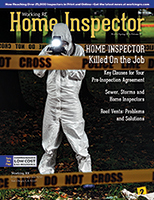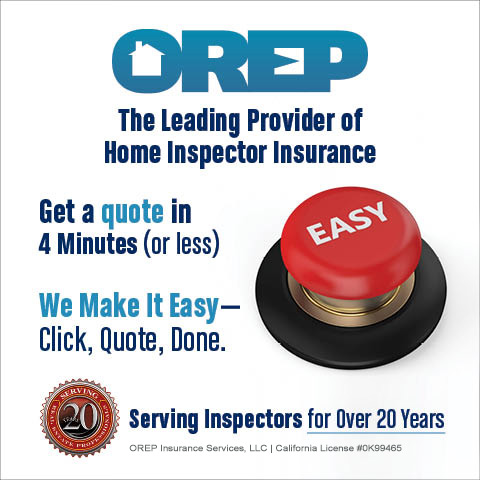 | > E&O/GL Insurance for Home Inspectors Competitive Rates, Broad Coverage, Free Risk Management, online inspection support for tough questions, discounts on education and more... Professional Coverage, Competitive Pricing Shop OREP today! |
>> Editor’s Note: To help you stay up-to-date and connected, OREP/Working RE has established a Coronavirus (COVID-19) Discussion and Resource Page where you can share your thoughts, experiences, advice and challenges with fellow inspectors. See what Inspectors are saying here!
“Properties are under tremendous threat from these insects, and we have developed many ways to combat them. But before we can even consider dealing with an infestation we must assess and evaluate the property in question.”
Seeking Termites
By Jeff McGovern
Very early in my pest control career I was exposed to termites. I never forgot this one interesting fact that we were always supposed to relate to our perspective clients: “Termites damage more homes than fires, floods and tornadoes every year”.
In the decades since, that fact remains unchanged. We still face various subterranean and drywood species along with invasive ones such as Formosan and conehead termites. As a home inspector, it’s important that you have a solid working knowledge of the termites that threaten your service area. This information is normally available through the state where you are working and the educational institutions that support the pest control industry. Properties are under tremendous threat from these insects, and we have developed many ways to combat them. But before we can even consider dealing with an infestation we must assess and evaluate the property in question. In other words, we must perform what is commonly referred to as a termite inspection.
Pest control companies large and small are hired to quite simply to kill termites that are actively damaging a structure or prevent such a thing from happening in the first place. Once their initial work is completed various warranties or guarantees could be offered, providing peace of mind for the building owner.
Home inspection firms are hired to assess and evaluate a structure and determine the validity of various building systems then record true site conditions. This can vary from structural integrity to water systems, electrical systems, mold issues, air quality, plus any number of building concerns, even wood destroying organisms such as termites.
Understanding Termites
When it comes to termites, it’s important to understand what these insects are doing. They are operating in mostly concealed areas usually processing and recycling wood. The problem is, we are not really done with the buildings in question and feel they are being reclaimed a bit sooner than we would like! The structure we are being paid to inspect must be assessed and evaluated with regard to these insects. This means getting underneath, around, behind and on top of all areas that can be accessed for a proper job to be done.
Ideally the assessment should begin from a distance using a mapping program such as Google Earth. Enter in the address of the site and then view it based on termite history in that area. Knowing what went on in the past with other properties is helpful and these records are valuable. They might be from your own records or from local websites that provide information termites and pests in the area. The next thing to observe is the tree cover in the shot viewed. On average tree root systems mimic the overall branch spread so root systems under the structure can be figured. This means wood under the structure where termites will forage—eventually finding the building itself.
From a termite standpoint, once you arrive at the site, reaffirm the exterior conditions. Trees, their position to the structure, any moisture conditions, drainage issues, mold, and exterior planted areas not allowing the structure to breathe should all be noted. In addition, look for any obvious signs of termite damage to the structure or other conditions such as soil grade over the siding above the foundation.
(story continues below)

Tools Needed
The tools needed for a proper assessment and evaluation will vary. Climbing may be necessary so a ladder will be required. An extendable pole is another reach up, down or across option. Probing or sounding tools can also prove valuable in HTML clipboard n doing a more detailed check-in of areas of suspected termite damage. Personal Protective Equipment (PPE) is also going to be a requirement. We must protect ourselves doing this kind of work that requires crawling, climbing, and being in seldom used spaces. Eyes, ears, nose, skin, fingers, hands, toes, and feet must all be protected. The old saying: “protect the points and joints of the human body” make sense here as well. At the end of the workday, we want to go home with the parts we came with all still intact.
Use common sense in the PPE you protect yourself with; it needs to match the environment where you’ll be. Wear a bump cap or similar head protection that fits the space you are working and stays in place while you move within that space. Eye protection is beyond the glasses worn just to see, they need to protect the user from dust, liquid and particulates kicked up during the assessment. Breathing protection could also be a requirement. Wear the proper respirator or mask needed for the space. Gloves must also be appropriate to the site being checked. While surgical gloves are appropriate in a more finished environment with viral concerns, they are not so good in a crawl space or attic. Here those gloves could be pierced or torn, exposing skin, so a more robust leather or heavy cut proof glove is a better choice. In some situations, hearing protection might be required so having the proper types of earplugs is important.
The type of clothing worn is also critical. Inside the finished area of a home it is usually a matter of protecting that space from us. A light coverall over our normal clothing prevents anything we might have brought in from outside, soiling the inside. In that same vein inside shoes or shoe covers should be considered. For the crawl space or attic clothing requirements change. In many situations, heavier protective crawl suits and footwear, even to the level of steel toed boots, are the best choice. Depending on the situation many firms would also add knee pads and elbow pads to the mix.
We also need to be able to see in dark places. Personal lighting or flashlights have changed dramatically thanks to LEDs and lightweight rechargeable batteries. These devices are available in a tremendous number of configurations and price ranges. Buy the ones that fit your needs in the spaces you and your team need dependable lighting. The basic rule of any lighting tool is simple “one is none and two is one”. Always have a backup on your person just in case. Being in the back of a dark attic or crawl space is a whole different game when lights go out. In addition, along those vision lines a pair of binoculars can be very helpful outside as well as inside a structure.
Documentation is an important part of the assessment process. When we are finished it allows us to properly create the report, we need to complete the job during the evaluation of our findings. It might be as simple as paper, pen, and pencil. Or as sophisticated as digital imaging and video work. In any case, we must indicate all we have seen and investigated to give a complete easily understood report back to the client. At the same time any recommendations we are qualified to make need to be clearly understood for future action. Once this reporting is done it must be clear as to the time, date, and site conditions when the event took place. This work is a snapshot in time and only through proper documentation are we and our firm defensible should a legal situation develop.
New Tools
There are new tools available for the detection of termites that will easily fit into today’s assessment process. A great new option is detection equipment has been used for decades in the HVAC industry to detect small amounts of refrigerant that could indicate a leak in a system. That same very sensitive UV gas detection technology is now set up for use in the termite arena detecting small amounts of the off-gas secreted by live insects. This allows a well-trained inspector to zero in and confirm live termites in many situations. Damaged areas located during the process can be easily checked for signs of life. Therefore, we can verify whether the damaged areas have or do not have live activity. In addition, areas that are in tight voids or concealed can be checked with the equipment to further enhance the value of the assessment.
About the Author
Jeff McGovern is nationally recognized in the pest control industry. In 1973, Jeff began working in the pest control industry and held various positions within several companies that allowed him to travel throughout the United States and South East Asia. His “12 Key Factors” program is currently in use by professional pest control operators and clients around the world. Jeff’s mission continues to drive change in the pest control industry.
OREP/WRE Coronavirus Discussion and Resource Page
Coronavirus: National Home Inspector Survey
Real-Life Inspector Lawsuits and How to Protect Yourself
Available Now
Presenter: Isaac Peck, President of OREP
Isaac Peck, President of OREP Insurance Services, shares his insights and advice gained over nearly 10 years of providing risk management and E&O insurance for home inspectors. You will not hear many of these insights anywhere else.
Watch Now!
Send your story submission/idea to the Editor:
isaac@orep.org
Note: The Winter/Spring 2022 Working RE Home Inspector is now mailing to over 25,000 home inspectors nationwide. OREP Insureds/members enjoy guaranteed delivery of each print magazine and many more benefits.


